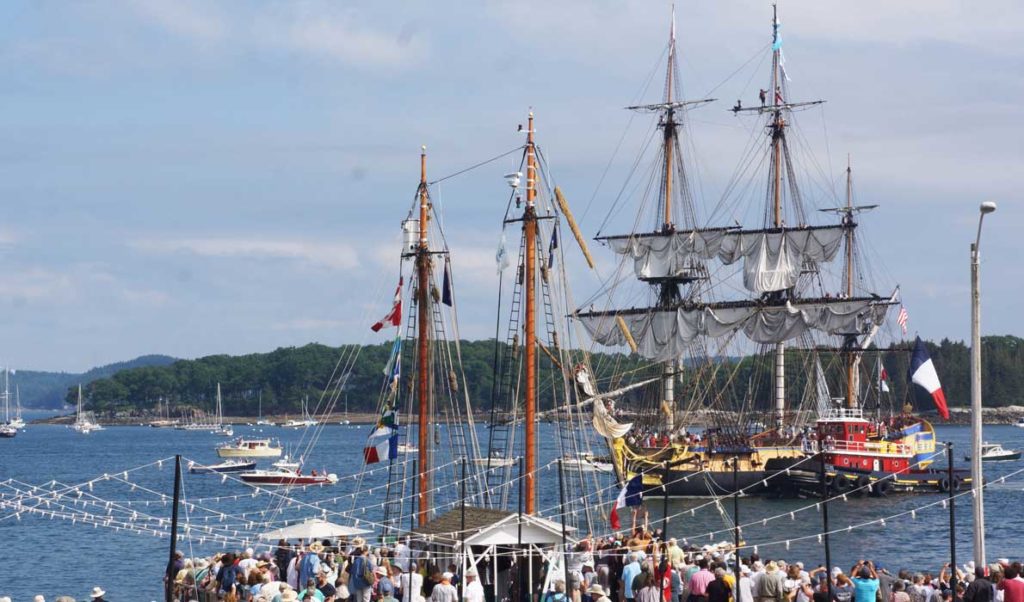Christmas truly came in July for the tiny town of Castine and it is hoping the gift it received will keep on giving.
The gift was a two-day visit from the tall ship Hermione—a replica of the 18th-century frigate that brought the Marquis de Lafayette to the United States in 1780 with a message of support for Gen. George Washington from the king of France.
With an estimated 14,000 people in town for the visit, Castine’s merchants did four to six times the business they would normally have done on a busy weekend in the summer, said James Goodson, Castine’s town manager.
Rentals, inns and hotels all around the area were booked months in advance and restaurants, galleries and gift shops were hopping over the course of the event that ran July 11-15, culminating with the two-day visit by the Hermione (pronounced err-me-own).
“From the town’s perspective, this is just a huge box wrapped up with an enormous ribbon on it,” Goodson said. “It was truly a gift to the town of Castine.”
The Hermione visit was orchestrated by the Castine Historical Society. The society spent about two years putting the event together with the help of Los Angeles-based event planner Community Arts Resources and the Friends of Hermione-Lafayette in America, a nonprofit organization supporting the re-creation and voyage of the Hermione, said Helen Miller, a member of the historical society’s board and the principal fundraiser of the organization’s Hermione event committee.
It was the town’s deep historic connections to the frigate and to France that convinced the friends group to add Castine to the Hermione’s U.S. tour itinerary, said Miles Young, the president of the Friends of Hermione-Lafayette in America.
According to the Castine Historical Society, the French were the first Europeans to occupy the Penobscot Bay area for any length of time and established a trading post there in the early 1600s. Castine is named after French military leader, nobleman and adventurer Baron Jean Vincent d’Abbie de St. Castin.
And the Hermione visited present-day Castine in 1780 on its historic voyage delivering the Marquis de Lafayette to the United States to inform Gen. George Washington that King Louis XVI would provide six ships, 5,500 troops, money and military goods to the U.S. in support of its struggle against England.
While Lafayette journeyed to meet Washington, the Hermione and its crew made a trip to present-day Castine on a reconnaissance mission to assess the British force occupying the area.
The event was the historical society’s idea. When one of its board members learned that the Hermione would sail to the U.S. and stop at multiple ports, it only seemed natural that Castine should be one of those ports of call, explained Miller.
But hosting the event in tiny Castine, with a population hovering around 1,400, would take money. The historical society didn’t ask the town to foot the bill, Miller said. The society raised $190,000, mostly through private donations. All the money raised went into supporting what the town would need to host a world-class event: hiring an event planner and infrastructure such as emergency services, security, restroom facilities and transportation services including shuttles and traffic control.
“The best part of this whole event was that everyone in the town was truly united and totally thrilled by this and there was such incredible energy,” Miller said. The hope is, she said, that they can keep that momentum alive.
James Goodson agrees.
“I think it’s our job to continue to use the photographs, the YouTube videos and social media to keep that buzz going as long as we can,” he said. But he is confident the town will be reaping the benefits of the Hermione’s visit for years to come.
The international press covering the event put Castine on the same footing as Boston, Philadelphia and Baltimore, and exposed the tiny community to a world-wide audience, he noted.
“The response … just goes to show that historical-cultural tourism is huge in Maine,” he said, and Castine has a lot of history and culture to share with visitors.
“I think people will come back to Castine to see all of our other facets,” he said. “I really think over the next year or two we will see bumps because of this.”





